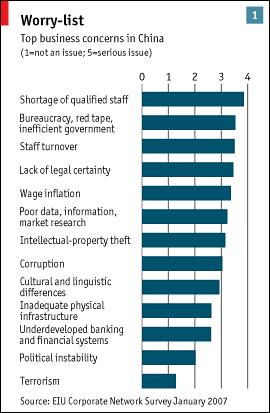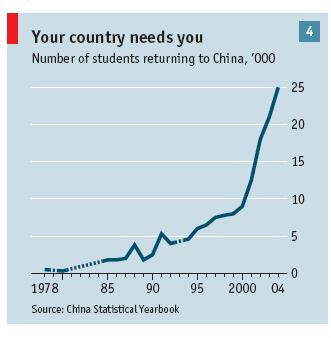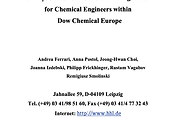Reaction
Paper #1
Science
and Technology Studies in China: The Question of “Innovation”
Langdon
Winner (Rensselaer Polytechnic Institute)
Jan
24 2008
Summary of Workshop
l China is
going to get own capacity of innovation
l China’s new
vision: 1) Endogenous innovation, 2) Harmonious development
l Political
constrains in Chinese schools (Curriculum and contents are restricted)
l RPI’s “Think
out of Box” education in Science & Engineering
l Who is an
Innovator?
n
Careful study of external/internal environment
n
Fine strategy
n
And then break it
l Democratic
social system is required to cultivate and sustain the innovation capacity in
China
n
Innovation comes from strong interaction with “End-users”
n
Creativity and cooperation are the key “terms”
n
Participatory practice in Science &
Engineering is recommendable to China
Does China
Need Democratizing HRD to Improve Innovation Capability?
Quality of Personnel is one of the key factors
in Innovation process. Drucker (2002) suggested in his article “Discipline of
innovation” that innovation requires knowledge, ingenuity, and concentration.
But on top of these requirements, there are prerequisites such as hard working,
focused view, and purposeful vision. He pointed out if there is no diligence,
persistence, and commitment, innovation can not be achieved at all. Pearson
(2002) believes productive innovation – the kind that actually makes a company
more competitive – arises from disciplines practiced by only human resources
are more important than any other resources. Schumpeter J. (Edited by Clemson,
the Essay, 1954) said whenever the economy or an industry or some firms in an
industry do something else in a new way, outside of the range of existing
practice, we may say it as a creative response:
Creative
response has at least three essential characteristics. First, from the
standpoint of the observer who is in full possession of all relevant facts, it
can always be understood ex post; but it can practically never be understood ex
ante; that is to say, it cannot be predicted by applying the ordinary rules of
inference from the pre-existing fact … creative response-the frequency of its
occurrence in a group, its intensity and success or failure-has obviously
something, be that much or little, to do (a) with quality of the personnel
available in a society, (b) with relative quality of personnel, that, with
quality available to a particular field of activity relative to quality
available, at the same time, to others, and (c) with individual decisions,
actions, and patterns of behavior.
As described by Drucker, Pearson and Schumpeter,
the most important resource for innovation is the human beings. Specifically
the most valuable human resource for making new products or processes – more
focused on the tangible innovation – is scientist and engineer. So, we can say
the quality of scientists and engineers decides the level of innovation
capability of organizations or countries. In this sense, cultivating qualified
innovation leaders, usually who comes from various science and engineering
field, is quite critical to increase the innovation capability.
What is the problem of Human Resource in China?
Economist (Aug 16th 2007)
reported the most concerning thing to make a business in China is “Shortage of qualified
staff.” Other Human resource issues are also listed high in business person’s
worry-lists such as “Staff Turn over,” ‘Wage inflation,” “Cultural and
linguistic differences,” and “Intellectual-property theft.” In the same report,
the survey result of successful HR initiatives in south-east Asia was also
provided. The top five successful HR practices are
1.
Increased training
2.
Mentoring System
3.
Personal-development plans
4.
Raise wages at greater than market rated
5.
Subsidized education/schooling
Except the number 4, successful Human Resource practices
in Asia are highly related with education, training and development to improve the
quality of human resource.

Source: Economist (Aug. 16th 2007): Capturing Talents
HRD, the activity for improving the quality of
human resource
As mentioned by Dr. Langdon Winner, the
education is seemed the only one method to improve the quality of human
resource. Especially the education over college level and workplace has direct
influence to develop innovation capability. McLean & MacLean (2001) defines
the Human Resource Development (HRD) as
HRD
is any process or activity that, either initially or over the long-term, has
the potential to develop adults, work-based knowledge, expertise, productivity,
and satisfaction, whether for personal or group/team gain, or for the benefit
of an organization, community, nation or ultimately the whole of humanity.
Conventionally, HRD have focused on Training
& Development (T&D), Organization Development (OD), and Career
Development (CD). But these days, as McLean’s new definition, HRD roles are
expanded into strategic and national level to help improving the quality of
human resources.

Source: Economist (Oct. 07th 2006):
The battle for brainpower
Then we can say the importance of HRD to improve
quality of people for Innovation is highly emerging not only in developed
countries but also in developing country from staff level to top executives and
top science and engineering talents including policy makers
China needs more democratizing HRD in
order to improve innovation capability
As taking a lunch with Dr. Winner, I asked a
question “What China should do to develop future innovation leaders?” Then, he exemplified
a young RPI graduate who participated in Siemens Management Program. Dr. Winner
suggested that targeted and focused developing for young talents might be the answer
for my question. But I though that it was not wrong in short-term but in the
long-run China might need more democratic education and HRD practices to develop
it’s innovation capability. My rationale for supporting democratic HRD comes
from my own experience at management program in Europe (German MBA) and
learning from Leadership Development Program in UIUC.
Targeted and
Focused HRD can discourage motivation in whole level.
When I participated a management development
program in
Innovation
leaders comes from all levels in an organization
Noel M. Tichy (2005) suggested a ’Teaching
Organization’ to explain what is the core competency of winning organization.
Dr. Jeff Flesher, a professor at UIUC HRE department, taught this concept by using
GE’s Leadership development program case. General Electric is now accepted that
it is one of the strongest/richest Leadership pipeline in the world. GE was
totally transformed by Jack Welch, a UIUC alumni of Chemical Engineering, who
devoted himself to establish the ‘Leadership development for all level.’ Jeff
said the key success factor of GE leadership development is highly based on the
‘Democratic HRD practice’ with strong drive and teaching from the top. He added
that democratic practice in an organization can encourage participation and it can
lead the real innovation in all level.
Conclusion
From Dr. Langdon Winner’s lecture, I have
learned three things. One, China is emerging not only in manufacturing but also
in every industry. Two, China is on the tip of decision making: changing social
system to improve their competency for innovation. Third, education is the key
for innovation in all countries.
Although my question “How can we develop future
innovation leaders” is not yet answered from the workshop, it motivated my
research interest about innovation leadership development. I hope to continue
this important research topic and someday have an answer at the end of this
workshop series.
References
Clemence, R. V. (Ed.). (1951). Essays.
"the creative response in economic history (reprinted from journal of
ecnomic history, nov. 1947, 149~159)", edited by richard V. clemence.
Cambridge: Addison-Wesley Press.
Drucker, P. F. (Aug., 2002). The discipline of
innovation. Harvard Business Review, Vol. 80(Issue 8), 95-101.
Economists (Oct. 07th
2006): The battle for brainpower
Economists (Aug. 16 2007). (Aug. 16th 2007): Capturing Talents
Pearson, A. E. (2002). Tough-minded ways to get innovative.(best of HBR 1988)
Gu S. & Lundvall B. (2006),
Tichy, N (2005). , The Leadership Engine: How
winning companies build leaders at every level, preface, xx~xxiii.


댓글